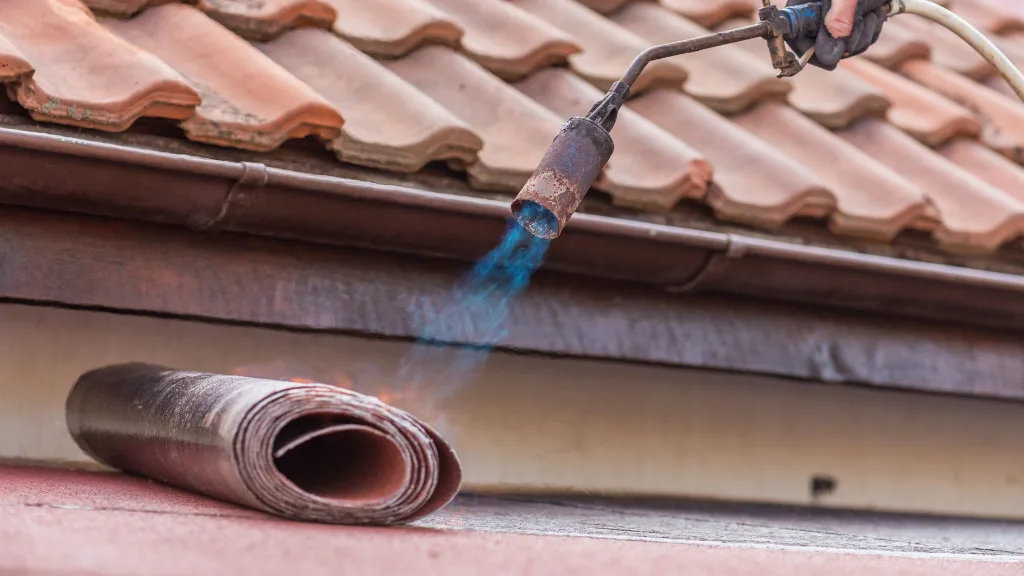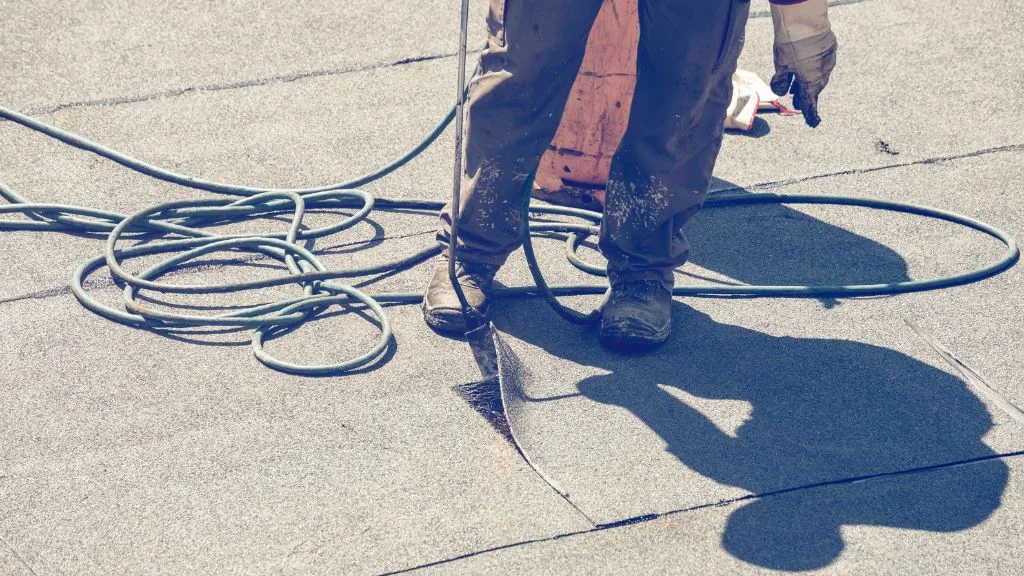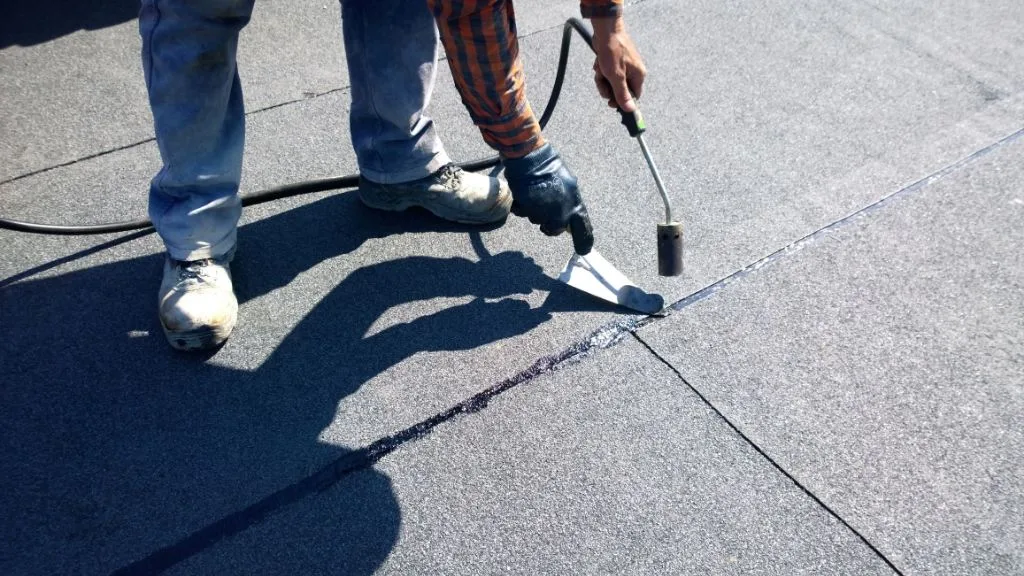
There are many different roofing materials to choose from for your home. One of the more popular types is torch down roofing.
Torch down roofs have a few advantages and disadvantages that need to be considered before deciding on one type of material over another.
The pros and cons of torch down roofs will be discussed in this blog post, so you can make an informed decision when considering what kind of roofing material you want for your home!
What is a Torch Down Roofing?
Roofing that is either flat or has a small slope is known as torch down roofing. Torch down roofing is a bitumen membrane with a propane torch.
Torch down roofing is a popular choice for watertight roofs. Torch down roofing is a great choice where water damage is a concern. Torch down roofing is also a great choice for flat roofs that require water tightness.
The torch down roofing process consists of applying hot bitumen to the membrane with an open flame, then troweling it to form smooth seams. Torch down roofing is used on commercial and industrial buildings like warehouses, schools, garages, restaurants etc.
Torch down roofing is popular for homes with flat roofs because it seals against water. Torch-down roofing is a type of roofing which isn’t for everyone. Torch down roofing is a rolled sheet.
The roofing material is layered from the bottom up with a thermo-fusible film, then modified bitumen, reinforced polyester, another layer of modified bitumen and a granulated mineral surface for a 3 layer roof as its third layer.
Layer 1 – Thermo-fusible Film – Holds the material together (think of it like Saran wrap)
Layer Two – Modified Bitumen – Strong adhesive that adheres to anything, especially itself.
Layer Three – Reinforced Polyester Matte Fiberglass – This is what gives the roof its strength and durability. It acts as a foundation for applying the next layers.
Layer Four – Modified Bitumen – This is the adhesive that actually sticks to other surfaces and gives you grip on your roofing material (think of it like glue).
Layer Five- Granulated Mineral Surface – It has a rough surface which prevents slipping, increases traction and resists aging. It looks just as good as regular asphalt shingles. It is the least expensive option of all five choices.
The Different Types of Torch Down Roofing
There are two types of torch down roofing, the hot and cold, with or without self-adhesive sealant overlay membrane.
Hot – The melted adhesive coating replaces the propane burner flame which will give you a stronger, more durable roof.
Cold – No propane burner flame is used to apply the melted adhesive coating which will give you a less expensive option for your torch down roofing project.
A cold applied membrane does not have as much durability as one that has been heated or hot applied and it takes longer to install because of the added steps.
Hot Torch Down Roofing
If you choose hot torch down roofing, it will be a little more expensive but the benefits outweigh those costs. The installation time is much faster and results in fewer seams/joints for water to seep through.
- Hot applied adhesive bonds better with itself which can lead to a stronger bond at joints as well.
- It also results in a much stronger seal against water and leakage, which can save you money on your energy bills as well as adding to the life of your roofing material.
- Hot Torch Down Roofing a method of installation typically used on low-slope commercial roofs. This type of roof is known for its wide coverage areas and the fact that it requires a torch to install.
- The metal panels are slipped under a row of shingles and lit on fire with one or more torches; the adhesive melts and fuses the panels in place, while the heat produced by the fire causes the asphalt in the shingles above to flow into and seal any seams.
- A metal drip edge is fitted around the roof’s perimeter, which also helps to contain the shingles at each course; it may be necessary for workers to cut pieces of sheet metal with an angle grinder, depending on available roof access and roof pitch.
- While the metal panels are relatively thin, this method is still not a good choice for roofs that receive a large amount of foot traffic because even though they may be less prone to blow off in high wind conditions more caution should be taken while going on or off the roof.
In addition, if any repairs need to be made to the roof, contractors must remove any shingles above the repair area and apply additional adhesive before installing a new panel. This can create a great deal of waste if a large number of panels need replacement.
Cold Torch Down Roofing
The cold applied membrane is less expensive than hot but it will take longer to complete the installation process and has lower durability rating than its hot counterpart.
With cold torch down roofing, you will need an open flame to melt the adhesive on your membrane; this can be done with propane or natural gas burners which are either mounted on carts or carried by hand.
- If you choose cold applied adhesive coating without self-adhesive sealant overlay membrane, it is basically like installing a rolled roof.
- You will not have any joints to worry about, just an even surface for your material of choice.
- Cold applied adhesive coating with self-adhesive sealant overlay membrane is the most expensive option because it requires two different installation processes but also gives you the longest lasting results compared to hot or cold torch down roofing options without a self-adhesive sealant overlay membrane.
- The most popular choice for torch down roofing is hot with a self-adhesive sealant overlay membrane because it provides you the best of both worlds: durability and affordability without sacrificing time or quality of installation.
It also has all five layers which will give you the strongest bond against water leakage. You will get the benefits of a hot applied adhesive coating with an added durable sealant overlay membrane.

The 2 Layer and 3 Layer Torch Down Roof Systems
“Torch down” roofing is a type of system with either two or three layers
- The 2 layer torch down roof is made up of 1 base sheet and 1 cap sheet. A 2 layer torch down roof will not last as long or offer benefits that a 3 layer torch down roof would.
- A three layer torch down roof has an additional cap sheet with a granulated surface. A granulated cap layer on a three-layer roof adds efficiency, curb appeal, fire resistance and durability.
Modified Bitumen Membrane
Modified bitumen membranes are used to make torch down roofing materials. Two types of modified bitumen membranes may be used to make torch down roofing.
Atactic Polypropylene or the APP
The APP modified bitumen membrane is the more expensive option but it provides better elasticity and works well in colder temperatures.
If you plan on having your torch down roof installed during winter months then you will want to go with an APP membrane because it has better elasticity in colder temperatures.
Styrene Butadiene Styrene
Styrene Butadiene Styrene is used to create modified bitumen for torch down roofing. Styrene Butadiene Styrene modified bitumen are more flexible and tear resistant than APP membranes.
SBS is a bitumen that has been altered to make it softer and lower melting when compared to APP. Self-adhering and cold-process membrane can be used in the torch down roofing, as well as other types of roofs.
Application of Torch Down Roof
There are two types of roof systems, a two-layer and three-layer. Here are some steps you can consider:
1. Attach the insulation – you can attach the insulation before or after installation of torch down roofing.
2. Lay down the moisture barrier – this is an optional step but it will help prevent leakage.
3. Get the overlay board installed – the overlay board is the component that holds your torch down material.
4. Time to apply your base sheet – make sure to have the adhesive facing up.
5. Apply the membrane and cap sheet – remember this will be a hot process.
6. Install the flashing – this is an optional step that helps protect the roof.
If you want to learn more about torch down roofing, contact your local supplier or contractor for details on installation procedures.
Pros of the Torch Down Roll Roofing
Resistance to Water Leakage – this is a major benefit of using torch down roofing. When the roof is flat, it becomes much more difficult to do this job.
Snow on the roof may melt off very slowly. Torch down roofing is a highly water-resistant flat roof system. Torch down roofing prevents water from collecting on a roof and promotes drainage. Torch down roofing is used to protect structures from snow buildup.
Long-Lasting Protection Against the Elements/Durability – you will have protection for years without having to worry about regular maintenance or replacement costs. The modified bitumen sheets don’t crack or split when the temperature changes.
Torch on roofing is a material that works well in any climate. Torch down roofs last longer, at 15 to 20 years. Torch down roofing is a long-lasting roof system. This material has the ability to withstand high temperatures and water damage.
Versatility with Different Roof Systems – torch down roof can be used on flat roofs, low sloped roofs and steep sloped roofs.
Energy Efficient – torch down roofing is energy efficient because it has an insulating value of 0.31 per inch. Torch down roofing provides protection against heat and UV rays. If you have a torch down the roof, it can help lower your cooling bill.
Fumes are Less Harmful – torch down roofing emits fumes that are less harmful than regular asphalt based roofs. Torch down roofing is highly fire resistant.
You should consider the fumes of a torch-down or mop-on roof coating before deciding which one to use. Torch down roofing emits much less harmful fumes than mop on asphalt roofing. When roofing, your roofer may need to take more breaks.
Ease of Installation – torch down roofing is a very easy installation process. You can even do it yourself! The process of installing a rubber roof is less intensive and cheaper than other types.
Easy Repairs – torch down roofing is easy to repair which means you will not have to spend money on hiring a contractor.
Cons of the Torch Down Roll Roofing
High Price Tag – this will be one of your most expensive options for roofs because you are getting three layers instead of two or four.
Installation Time – if you don’t have a lot of time to do the installation yourself, you will need to hire someone which brings costs up. The installation may take too long for you especially if you aren’t a roofing expert.
Seam Failure – if you do not have a flat roof, there is an increased risk of seam failure. If a roof has three layers, it may still leak. A repair to seal the roofing seam is quick and easy if it does happen.
Availability – torch down roof is offered by less suppliers compared to other options like shingles or metal roofs.
Fire Hazard – since the installation process is hot, you are more likely to have a fire hazard. Modified bitumen is a fire-resistant material that can be used as construction. If the compound is overheated during installation, it can become flammable.
Trapped Water – if you are in a cold climate, there is an increased chance of trapped water. If water gets trapped between the layers of rolled roofing, it can cause problems. Roofing should only be applied or repaired when dry.
Torch Down Roofing Cost
There are many different contractors for torch down roofs, and the price of the roof will depend on who you choose to do it. There are materials for roofing that are of lower quality and higher quality.
With high-quality torch down roofing, you might have to pay a little extra at installation. You will get a lower cost for repairs and replacements to your roof, which will save you money in the long run.
Conclusion
For slightly pitched roofs, the torch down roof system is best. Torch down roofing is used to build roofs that are not affected by harsh weather conditions. Torch down roofing is durable and ensures a secure, leak-free home.
Torch down roofing must be installed by professionals, and is not something DIYers can do. Torch-down roofing is a long lasting and durable option for flat roofs.


